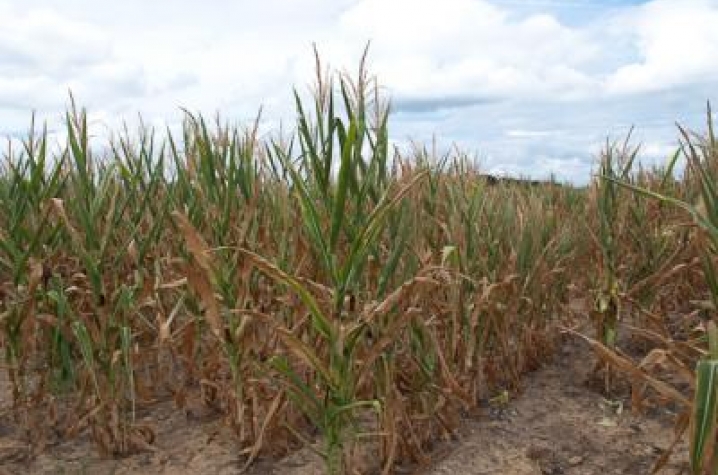Kentucky Corn Crops Suffering From Drought; Vineyards Facing Challenges
LEXINGTON, Ky. (July 24, 2012) ― From corn to grapes, crops have been suffering during Kentucky's dry summer.
The extreme drought in Western Kentucky has drastically decreased corn yield potential. As a result, many farmers are making decisions about what to do with the crop. Meanwhile, the expanding vineyard industry in Kentucky is facing its own challenges from the dry weather.
According to Kentucky Weekly Crop and Weather Report for the week ending July 15, 77 percent of the state’s corn crop was rated poor or very poor. While rain is needed, it may do little to help the crop as 90 percent of it has already tasseled and 76 percent has silked.
“As far as harvesting a crop, this is the worst I’ve seen since I’ve been here,” said Susan Fox, who’s been Lyon County’s agriculture and natural resources agent with the University of Kentucky Cooperative Extension Service for the past seven years. “The timing of the extreme heat combined with severe drought at tasseling was terrible for corn pollination.”
Since March, the nearest weather station in Princeton has received 8.45 inches of rain, which is 14.39 inches below normal rainfall totals, said Tom Priddy, UK agricultural meteorologist.
Some of the producers in Lyon County have made the decision to cut at least a portion of their crop for silage to feed to their livestock.
Given the drought and the condition of the corn, UK College of Agriculture specialists agree that making silage from the crop to feed to ruminants can be a viable option for farmers. Drought-stressed corn harvested for silage can be 60 to 100 percent of the normal feed value of regular corn silage, depending on how much of the crop was damaged and the amount of grain in the silage.
Before harvesting corn for silage, UK specialists encourage producers to contact their crop insurance agent so they understand the rules and choices associated with silage in their policy.
Corn should be harvested for silage when the moisture content is between 60 to 70 percent depending on the storage method. Producers should test each field for nitrate levels to determine which fields to cut for silage. Heat and drought can make nitrate levels higher, especially in the lower third of the plant. High nitrate levels could result in nitrate poisoning of livestock. Silage should ferment four to six weeks. The fermentation process will considerably lower nitrate levels, but producers should have their silage tested again after fermentation is complete before feeding it to animals.
The UK Veterinary Diagnostic Laboratory performs forage nitrate/nitrite testing. The cost is $15 per sample. Producers can take samples to their county extension agent or send them directly to the lab. For more information on how to collect a sample for nitrate testing, visit http://www.uky.edu/Ag/GrainCrops/Briefs/nitrate_testing2012.html. More information on harvesting corn for silage, baleage or hay is available at http://graincrops.blogspot.com/2012/07/considerations-for-harvesting-dro.... For more information on the drought in Kentucky, visit the Kentucky Drought Resources Web page at http://drought.ca.uky.edu/.
This summer's weather is bringing a whole new meaning to dry wine as grape growers deal with the heat and dry conditions as well. Grapevines are deeply rooted and have a great knack for finding water in periods of drought; however, the 2012 drought has proved challenging for even the most tenacious vines.
“With the below-average rainfall and extremely high temperature spikes we’ve experienced here in Kentucky, we want to make sure grape growers monitor their vineyards for symptoms of water stress,” said Patsy Wilson, University of Kentucky College of Agriculture viticulturist. “This is especially true for newly established vineyards.”
Wilson said a mild degree of stress is not harmful, but severe stress can reduce crop levels and delay fruit ripening, potentially harming fruit quality and vine health in both current and subsequent vintages.
“Mild water stress occurring between bloom and veraison (the onset of ripening) may actually be beneficial,” she said. “However, a high level of water stress on vines between veraison and harvest is less desirable due to its negative impact on fruit ripening and potential vine quality.”
Water availability once ripening begins is important for the vines, and heavily cropped vines need more water than lightly cropped vines.
To recognize water stress, growers should examine their vineyards and realize that initial drought stress will appear in areas of the vineyard with restricted rooting depth and lower water-holding capacity. Suffering vines will potentially begin to lose leaves.
“Growers may also notice increased leaf temperature, wilting, leaf scorch and suppressed growth and death of terminals and tendrils,” Wilson said. “Simply walking through the vineyard and feeling large leaves that receive direct sunlight can be a quick and useful tool to identify drought stress; the leaves will feel warm.”
It will also be important for growers to carefully manage the canopy during periods of high temperatures. Growers need to be careful with late-season shoot positioning and leaf pulling and make sure they don’t suddenly expose fruit to direct sunlight; it could result in fruit burn.
While periods of drought and high heat can have negative impacts on vine performance, Wilson said excessive water stress from ripening to harvest may also lead to poor wine quality, including reduced aging potential.
For a more information, including photos of leaf damage, please visit http://www.uky.edu/Ag/Horticulture/vinewsv1i2.pdf.






